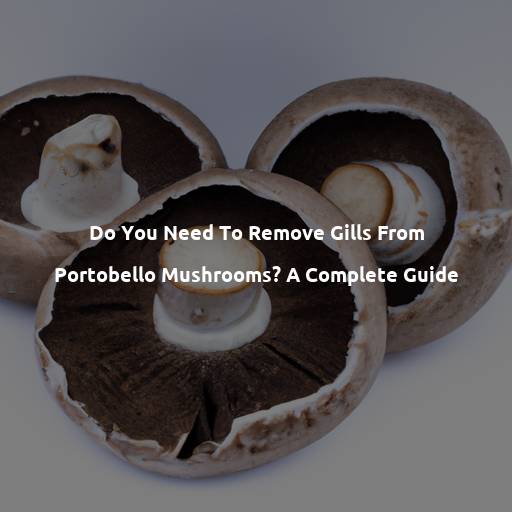Introduction to Portobello Mushrooms
Portobello mushrooms, also known as Agaricus bisporus, are a versatile and popular ingredient in many dishes. With their meaty texture and distinctive flavor, they have earned a place in both vegetarian and meat-based cuisines. In this blog post, we will explore everything you need to know about these flavorful fungi, including their unique features, culinary uses, and the topic of removing gills. So, whether you’re a seasoned chef or an aspiring home cook, let’s dive into the world of portobello mushrooms and discover the secrets they hold.
Understanding the Purpose of Mushroom Gills
Mushroom gills are an integral part of the portobello mushroom. Located on the underside of the cap, these gills serve a purpose in the reproductive cycle of the fungus. The gills are responsible for producing and dispersing mushroom spores, aiding in the growth and spread of new mushrooms.
The gills of the portobello mushroom are designed to maximize the surface area for spore production. Their thin, densely packed structure allows for efficient spore release when conditions are favorable. As the cap of the mushroom matures, the gills darken and begin to release spores, which can be seen as a fine powder.
While mushroom gills have an important role in the natural life cycle of the fungus, some cooks prefer to remove them before cooking. This can be due to personal preference, as the texture and appearance of the gills may not be appealing to some individuals. Additionally, removing the gills can prevent the release of excess moisture during cooking, resulting in a drier mushroom cap.
It’s important to note that removing the gills does not significantly alter the flavor or nutritional value of the portobello mushroom. The choice to remove or keep the gills ultimately depends on one’s culinary preferences.
In the next section, we’ll explore the pros and cons of removing mushroom gills, allowing you to make an informed decision when preparing your portobello mushrooms.
Pros and Cons of Removing Mushroom Gills
Removing the gills from portobello mushrooms is a debated topic among mushroom enthusiasts. While some prefer to keep the gills intact for aesthetic appeal and added flavor, others opt to remove them for various reasons. Here are the pros and cons to consider when deciding whether or not to remove mushroom gills:
Pros:
1. Improved appearance: Removing the gills can give the mushroom a cleaner and more visually appealing appearance. This can be especially desirable when using portobello mushrooms as a main ingredient or for presentation purposes.
2. Enhanced texture: By removing the gills, you can achieve a firmer texture in the mushroom cap. This can be beneficial when grilling, baking, or stuffing the mushrooms as it allows them to hold their shape better.
3. Reduced cooking time: Removing the gills can help expedite the cooking process as they tend to release moisture when heated. Without the gills, the mushroom cap can cook more quickly and evenly.
Cons:
1. Loss of flavor: The gills of portobello mushrooms contribute to their earthy and rich flavor. Removing them may result in a slight loss of taste, which could be undesirable for those who appreciate the unique flavor profile of portobello mushrooms.
2. Extra prep time: Removing the gills can be a time-consuming task, especially if you are dealing with a large number of mushrooms. This additional step might not be convenient for those looking for a quick and easy cooking experience.
3. Waste of edible parts: Some argue that removing the gills is unnecessary since they are perfectly safe to eat and provide additional nutrients. Discarding them can be seen as wasteful and lacking in sustainability.
Ultimately, the decision to remove or keep the gills of portobello mushrooms depends on personal preference and the specific recipe you are preparing. Consider the pros and cons mentioned above to determine the best approach for your culinary needs.
How to Remove Gills from Portobello Mushrooms
To remove gills from Portobello mushrooms, follow these simple steps:
1. Start by carefully inspecting the mushroom cap. Look for the thick, dark gills on the underside.
2. Using a small spoon or knife, gently scrape the gills away. Be careful not to damage the mushroom cap in the process.
3. Continue scraping until all the gills are removed. You may need to rinse the mushroom under running water to remove any loose gills.
4. Once the gills have been removed, pat the mushroom cap dry with a paper towel before using it in your recipe.
Removing the gills from Portobello mushrooms is a matter of personal preference. While some argue that leaving the gills intact adds flavor and texture to dishes, others prefer to remove them as they can release excess moisture when cooked.
By removing the gills, you create a smooth surface on the mushroom cap, allowing it to absorb marinades or hold fillings more effectively. Additionally, removing the gills can enhance the visual appeal of your dish.
It’s important to note that removing the gills may result in a slightly milder flavor compared to leaving them intact. However, the difference in taste is minimal and might not be noticeable in many recipes.
Whether you choose to remove the gills or not, Portobello mushrooms remain a versatile ingredient in various dishes. So, feel free to experiment with both methods and discover what works best for your culinary preferences.
Alternative Cooking Methods for Portobello Mushrooms with Gills
While it is common practice to remove the gills from portobello mushrooms before cooking, there are alternative cooking methods that allow you to utilize the mushrooms without removing the gills. These methods can help enhance the flavor and texture of the mushrooms, while still maintaining their natural form.
1. Grilling: Grilling portobello mushrooms with gills intact can impart a smoky and charred flavor to the mushrooms. Simply brush the mushrooms with olive oil and season with your desired spices or marinade. Place them on a preheated grill over medium heat, gill-side up. Flip them after a few minutes and continue grilling until the mushrooms are tender and slightly charred.
2. Roasting: Roasting portobello mushrooms with gills can concentrate their flavors and create a hearty, meaty texture. Preheat your oven to 425°F (220°C). Place the mushrooms, gill-side up, on a baking sheet lined with parchment paper. Drizzle them with olive oil and season with salt, pepper, and any desired herbs or spices. Roast for about 15-20 minutes or until the mushrooms are tender and golden brown.
3. Stuffing: Another delicious way to cook portobello mushrooms with gills is by stuffing them with flavorful fillings. Remove the stems and gently scrape out some of the gills to create space for the stuffing. Fill the mushrooms with a mixture of breadcrumbs, cheese, herbs, garlic, and any other desired ingredients. Bake the stuffed mushrooms in a preheated oven at 375°F (190°C) for about 20-25 minutes or until the filling is golden and the mushrooms are cooked through.
4. Sauteing: Sauteing portobello mushrooms with gills can help retain their natural juices and intensify their earthy flavor. Heat a skillet over medium-high heat and add some olive oil or butter. Add sliced or diced mushrooms to the skillet and sauté them for about 5-7 minutes, stirring occasionally, until they are tender and lightly browned. Season with salt, pepper, and herbs or spices to taste.
By exploring these alternative cooking methods, you can enjoy the unique taste and texture of portobello mushrooms without the need to remove their gills. Experiment with different flavors and techniques to discover your favorite way to cook these versatile mushrooms.
FAQs about Portobello Mushroom Gills
1. Are portobello mushroom gills edible?
Yes, portobello mushroom gills are edible. However, some people find their texture unappealing or prefer to remove them before cooking.
2. Can you eat portobello mushrooms without removing the gills?
Absolutely! The gills are safe to consume and contain nutrients. Whether you choose to keep or remove them is a matter of personal preference and the desired texture in your dish.
3. What are the advantages of removing portobello mushroom gills?
Removing the gills can help prevent them from releasing excess moisture while cooking. This can be particularly beneficial when grilling or sautéing portobello mushrooms, as it helps to enhance their firmness and prevent a watery consistency.
4. How do you remove the gills from portobello mushrooms?
To remove the gills, gently scrape them with a spoon or knife. Start from the center of the mushroom cap and work your way towards the outer edges. Be careful not to damage or puncture the cap while doing so.
5. Can you still stuff portobello mushrooms after removing the gills?
Absolutely! Removing the gills doesn’t impact the ability to stuff portobello mushrooms. In fact, it can create additional space for delicious fillings, such as cheese, vegetables, or breadcrumbs.
6. Will removing the gills affect the flavor of portobello mushrooms?
Removing the gills shouldn’t significantly impact the flavor of portobello mushrooms. The flavor primarily comes from the flesh of the mushroom cap, which remains intact even after gill removal. So, you can still enjoy their delicious earthy and meaty taste.
7. What cooking methods are suitable for portobello mushrooms with gills?
Portobello mushrooms can be cooked with or without their gills using various methods. Grilling, sautéing, roasting, and baking are all wonderful options that bring out their rich flavor and unique texture. The choice ultimately depends on your preference and the recipe you’re following.
These frequently asked questions provide useful information about portobello mushroom gills, answering common queries readers may have. Remember to structure your content in a concise and informative manner, using relevant keywords to optimize for search engines.
Conclusion and Final Thoughts
In conclusion, the decision to remove or keep the gills from portobello mushrooms ultimately boils down to personal preference and the specific recipe you are preparing. Removing the gills can enhance the appearance, texture, and cooking time of the mushrooms, while still maintaining their flavor and nutritional value. On the other hand, keeping the gills intact can provide a more earthy and robust taste to your dishes.
If you choose to remove the gills, simply follow the easy steps outlined in the previous section. However, if you prefer to cook portobello mushrooms with their gills, there are alternative cooking methods such as grilling, roasting, stuffing, and sautéing that you can explore. These methods allow you to enjoy the unique taste and texture of the mushrooms while still retaining their natural form.
Whether you decide to remove the gills or not, portobello mushrooms remain a versatile ingredient that can be incorporated into a wide range of dishes, from burgers to salads to pasta. So, don’t hesitate to experiment with different cooking techniques and flavor combinations to discover your favorite way to enjoy these flavorful fungi.
In the end, the key is to embrace the world of portobello mushrooms and let your culinary creativity guide you. Whether you’re a seasoned chef or an aspiring home cook, these fungi are sure to add a delightful and savory touch to your meals. Happy cooking!

